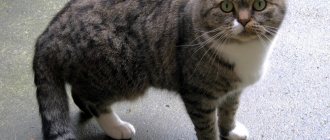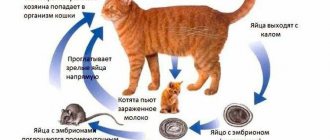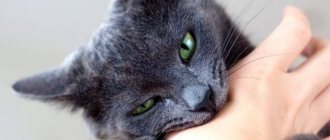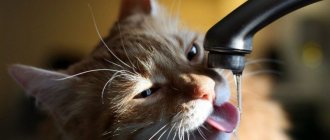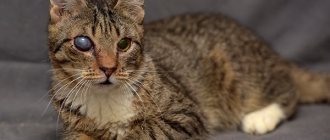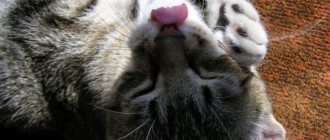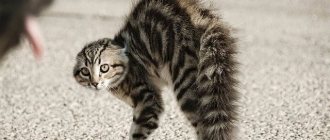Often after lambing, owners witness how a cat carries kittens. There are many reasons for such actions, starting with the owners’ excessive curiosity about furballs, and ending with postpartum eclampsia of the female. To save the lives of the younger generation, you should familiarize yourself with the main provoking factors and methods for eliminating them.
How does a cat carry kittens?
Instincts, character and behavior of cats
Instinct is an inherited quality that encourages the performance of rational actions based on an unconscious impulse. Such automatic signals are controlled by the central nervous system.
The strategy of cat behavior is based on the following instincts:
- self-preservation;
- prolongation of the family;
- territory protection;
- satisfy the feeling of hunger.
Due to the fact that cats are intellectually developed creatures, they have play and communication needs.
The desire to chase a running mouse is inherent in a cat at the genetic level.
In order for the trigger mechanism to work, awakening instincts, an irritating factor is necessary. For example, scratching or rustling sounds are a signal for furry pets to capture a victim.
Any reflex corresponds to a biological purpose and is interconnected with the outside world. Among the most important are hunting, sexual and maternal.
Since, thanks to the food instinct, the animal goes in search of food, it is one of the leading
Scientists combine all the studied instincts into several broad groups.
Table 1. Studied instincts in cats
| Category | Description |
| Ensuring the vitality of the body |
|
| Formative socialization |
|
| Allowing adaptation to the environment |
|
After the birth of kittens, maternal instinct comes to the fore
Animals kept in a limited area lose some of their behavioral patterns. This occurs due to the loss of their original meaning. For example, the hunting instinct undergoes changes in the process of domestication of cats. Running speed, jumping ability, good sense of smell, touch and hearing remain at the proper level, but the desire to catch prey gradually atrophies. The pet gets used to the daily feeding schedule and is not bothered by searching for food on its own.
In domestic cats, territorial and social instincts play an important role, especially maternal instincts. Regardless of the conditions of detention and other components, it does not lose its relevance.
The owner's concern for the pet leads to the extinction of the hunting instinct
Maternal instinct
The behavioral repertoire of a cat that has given birth is based on meticulous care for the offspring.
During pregnancy, in addition to producing the hormone responsible for milk production, the body produces oxytocin. This substance is responsible for the bond between cats and kittens. The mechanism of operation is simple. The smell of the female's amniotic fluid remaining on the babies stimulates recognition of the offspring. Therefore, olfactory signals play a significant role in the first 20 days after birth.
How to tell if a cat is pregnant
Caring for offspring changes with the development of the mental and physical state of children. In its absence, they are stunted in growth. For 3 weeks after giving birth, the female tirelessly looks after the kittens. If they crawl away from the nest, she brings them back. In most cases, kitten dragging is considered normal at this stage. The exception is the restless, repeated shifting of babies from place to place. This is caused by a dangerous postpartum pathology.
Scientists have found that it is safe for a kitten to be kept in a female's teeth. Certain impulses are formed in the animal’s brain that help maintain balance and better orientation in space when carrying offspring. In addition, babies instinctively assume the fetal position and pull their limbs towards their body, providing themselves with additional stability.
When placed in the mother's teeth, the kitten automatically takes on the form of a fetus.
Character traits
In addition to instincts, animals are governed by character. Along with reflexes, cats have a collection of well-developed individual behavioral strategies. The formation of the latter depends on the situation surrounding the animal. Depending on the personality traits of the female, the postpartum behavioral pattern may change.
The human cat loves to make a nest in the owner's bed
Researchers identify 5 types of cat personalities.
Table 2. Varieties of cat characters
| Type | Characteristic |
| Cat-man | Very sociable animals that need constant care. They are attached to the owner and do not skimp on expressions of feelings. They see themselves as family members and try to take part in the daily life of their owners. |
| Hunter cat | Has pronounced hunting instincts. Constantly chases birds, mice and enthusiastically runs after toys. Doesn't feel well in confined spaces. Needs walking. |
| cat-cat | He prefers spending time with representatives of the cat family to communicating with people. He likes to live in a couple and does not get bored in an empty apartment. Pets of this type can often be found rubbing noses with their own kind. |
| Grumpy cat | The most aggressive and independent type. He feels like the owner of the territory and does not allow encroachments on his property. Doesn't like to play with people, rejects affection. |
| Curious cat | Constantly absorbed in exploring the surrounding space, using the senses of smell and touch. Perceives new people positively and strives to be outside the home. An inquisitive mind often leads to a loss of control over a situation. |
Most cats have the ability to learn from their own mistakes and avoid repeating negative experiences. There is a theory that pets play out several possible options in their minds before performing any action.
Cats belong to the category of intellectually developed animals
In case of illness
A sick or wounded animal is not able to run away, hunt or offer serious resistance, therefore, in the natural environment, sick animals try to sit out in a shelter until the condition stabilizes.
The sensitive instincts of domestic cats force them to repeat the behavioral stereotype of their wild ancestors and hide away from prying eyes. You can suspect something is wrong if a pet hiding in a dark place:
- does not respond to calls;
- refuses not only the usual food, but also treats;
- becomes apathetic and indifferent to toys and fun;
- turns out to be unusually hot to the touch;
- constantly rubs sour eyes and nose with its paws;
- continuously licks any part of the body;
- unable to empty the bladder, or the urine has a strong odor and blood;
- experiences a frequent urge to vomit and/or defecate, and the feces are liquid with an admixture of undigested food residues, mucus and blood.
Cats experience temporary illnesses, but ignoring obvious signs of poor health is unforgivable carelessness. To dispel all doubts and take emergency measures in case of serious trouble, a depressed animal must be shown to a veterinarian without delay.
Why does a cat drag kittens?
Considering the fact that felines are smart creatures, dragging babies to a new place has good reason. They are guided by maternal instinct, which encourages them to preserve the viability of their offspring.
Table 3. Factors that cause a cat to bear offspring
| Incentive motive | Interpretation |
| Excessive curiosity of people towards newborns | If the owners constantly look into the nest, the female ceases to perceive it as reliable. In their natural habitat, animals hide their offspring in places remote from strangers and inaccessible to predators. Therefore, the cat always looks for a place with minimal traffic. |
| Close location to power source | 3 weeks after lambing, babies need additional feeding in addition to mother's milk. During this period, the animal tries to equip a home next to the kitchen. |
| The cat's inexperience | After the first lambing, not everyone becomes good mothers. Some females perceive the squeaking of babies as dissatisfaction with the location of the nest. In an effort to please the newborns, the cat moves the newborns to a new location. |
| Bad conditions | Dampness, drafts, cold, elevated air temperatures, and excessive light are not suitable for keeping offspring. |
| Contamination of the nest | Over time, the place where kittens are kept becomes dirty. Feces, secretions of the sebaceous glands and other cat waste have a negative impact on the condition of the litter and sanitary conditions in general. |
| Inconsistency between nest and kitten sizes | A box that is too large or small from the female's point of view is not suitable for keeping kittens. For example, for small children, a spacious basket will be unprotected and accessible to predators. Or, conversely, over time the box becomes narrow for older kittens. In any case, the female will go in search of a more comfortable place to place her offspring. |
| Excessive loudness in babies | If the kitten screams very loudly, in order to protect the rest of the offspring, the female will move it to another place. Indeed, in its natural habitat, a predator will easily find shelter at the sound of a baby’s squeak. |
| Postpartum eclampsia | A lack of calcium leads to a painful condition accompanied by disruptions in the functioning of the nervous system. Cats show excessive anxiety towards kittens and become aggressive. Females in this state are characterized by constantly dragging their babies to new nests. |
In some cases, carrying kittens by the withers is a characteristic feature of the breed. Similar behavior is observed in Bengal cats.
Female Bengal breeds often keep themselves busy carrying kittens
Negative consequences
Despite the fact that in most cases a change of place is dictated by safety and hygiene considerations, it can be life-threatening for children:
- Hit the floor. If the female is frightened during the transfer of kittens, she may drop the fragile newborn. A fall from the height of an adult cat is fatal.
- Injury to teeth. When dragging, the cat strongly squeezes the withers of the babies with its teeth. If the female is distracted, she may clench her jaw and cause harm.
- Staying unattended. When frequently transporting kittens, a cat sometimes forgets some of the offspring in the old place. Without milk and warmth, they die.
At the moment of dragging, you should not take the babies away from the cat. This will cause clenching of the jaws and injure the skin.
Kittens in the female's teeth should not be touched
Criteria for selecting a suitable location
Before building a nest for the future brood, the cat spends several days searching for the ideal corner. From the animal's point of view, it must have the following characteristics:
- secluded;
- difficult to reach;
- with dim lighting;
- hidden from prying eyes;
- cosy;
- clean;
- no pungent odors;
- warm.
Often females choose the master's closets with clean linen.
The choice of location is determined by the character of the cat. Compliant animals kitten in a place prepared in advance for them. Those who are self-sufficient and independent may refuse on principle the proposed nest. How to make a house for a cat? Read in the special article.
Cats love to create a home for babies in nightstands
How to stop a cat from carrying kittens
First of all, you should find out the reason that provoked the female to look for a new place for offspring. You cannot scold or punish a caring mother.
General recommendations:
- Close access to unsafe places. These are the space under the bathroom and the balcony.
- Find a new nest and help in its arrangement.
- Protect your cat family from other pets.
- In case of postpartum eclampsia, give injections of 2.5 ml of calcium gluconate every 40 minutes, but not more than 10 ml per day. For preventive purposes, Kinosil is used according to the dosage specified in the instructions.
Providing a safe, warm environment for animals is the best way to support them during the postnatal period.
"Kinosil" is effectively used to reduce the risk of eclampsia in cats
Undesirable consequences
There are certain dangers in having a cat constantly traveling around the apartment with small kittens. When dragging the cubs, they may be injured. A cat can drop them from a height, and at this age a fall can be fatal.
When carrying the baby, the mother squeezes it quite tightly with her teeth, and when the kitten is already quite old, she drags it with drag. This situation can result in injury or death. Under no circumstances should you take kittens away from your pet while she is carrying them. The animal instinctively clenches its teeth tighter and can harm the baby.
Constantly carrying babies, the cat often forgets them. Without food and warmth, a helpless kitten may die.
How to make a nest for kittens
If a cat behaves restlessly, constantly hides and is found in the most unexpected places, you should think about arranging a house for future kittens. If this process is left to chance, the female may give birth on a pile of bedding or in a clothes closet.
Advice from experienced cat lovers:
- A few days before giving birth, build 3 nests and place them in different, preferably dark, places in the apartment. When the cat chooses one of the proposed options, the rest must be removed.
- To arrange a cat's nest, take a box or basket of appropriate size. It is lined with soft fabric on the outside and inside, and material with a denser texture, such as baby diapers, is placed on the bottom. As an alternative, you can take an exhibition tent equipped with a door. If necessary, it can be closed and prevent children from dragging themselves around.
- In the room where the cat family will be, the optimal temperature should be set - not lower than 28°C. If necessary, use infrared lamps with a power of 250 W. At lower temperatures, babies may catch a cold. If a newborn's body temperature drops to 35°C, he or she develops aspiration pneumonia, which can be fatal.
The wardrobe is a favorite place for lambing among felines.
If you follow the recommendations listed and do not disturb the kittens, the cat will not drag the babies to a new place.
The birth and care of newborn kittens are dictated by the maternal instinct of the female. You should only interfere with this natural process if absolutely necessary. Any help should be unobtrusive and delicate, since no one can know better than a mother how to take care of babies.
Pregnancy
Any cat owner will tell you that pregnant cats sometimes behave very strangely and illogically from a human point of view.
During pregnancy, the animal's instincts, which have been ingrained over the centuries-old history of evolution, become more acute. The owner should take care of the pet rushing around the house in search of shelter and build a similar nest for the animal. The best option would be a regular TV box with some warm fabric at the bottom that absorbs moisture. Then the owner will not have to scour the house, looking for a hard-to-reach corner with helpless newborn kittens.
We suggest you read: How to wash a kitten for fleas? What shampoo and how often should I bathe him?
Pregnant cats can sometimes remain affectionate and flexible, still easily communicating with their owners, but most often these ladies are irritable and show aggression for any reason, meowing and hissing at their pets. Therefore, it is very useful to rid pets of annoying children’s attention, pestering and all sorts of harsh sounds, because the animal is already constantly tense and on the verge of exhaustion.
My cat's whiskers are falling out: why and what to do?
The essence of the problem
Maternal instinct is one of the strongest in animals. There are well-known cases where a cat risked her life and saved her offspring. Therefore, killing kittens is not considered normal. This abnormal behavior occurs for various reasons. Sometimes an animal kills its offspring through negligence. In some cases, cats eat newborn kittens.
This action requires detailed study, otherwise the situation may repeat itself.
Some males are also prone to cannibalism.
Pet owners do not always think about whether cats eat kittens. Some people do not consider it necessary to equip a special “nest” for a cat. Males kill offspring for various reasons: the desire to remove kittens from another cat, stimulating the female to go into heat, etc.
The main difficulty in early detection of cannibalism in cats is that there are no specific signs of abnormal behavior. The female kills her offspring unnoticed and does not do this in public.
If the animal is a breeding animal, then during subsequent births it is recommended to establish round-the-clock monitoring. Indirect signs of cannibalism are anxiety, tension, hissing and other manifestations of aggression towards kittens.
For your information! There is a popular belief that if a cat eats its offspring, this indicates the presence of damage to the owner. It is believed that in this way the animal protects humans from serious problems.
Pathological causes
The natural behavior of an animal is based on its instincts. Even millennia of domestication did little to change them. But in some cases, the cause of cannibalism lies in the illness of the mother.
Pregnancy can cause hormonal and mental disorders
To understand why the cat ate the kitten, you need to study its condition.
Due to various failures, the formation of the maternal instinct may be disrupted in the female. This happens especially often due to caesarean section. In this case, the production of oxytocin is delayed, and the cat perceives live kittens as strangers.
For your information! Sometimes everything is limited to aggression or ignoring the kids.
Maternal instinct may wake up after a while, but it’s better not to risk it. Childbirth takes a lot of energy from a cat, and she can eat her offspring. Therefore, in case of aggression on her part, the babies must be removed and fed independently.
Another reason why animals exhibit cannibalism is mental disorder. Such problems arise not only among people. They can be provoked by difficult childbirth, lack of a “nest,” the presence of people and other factors.
Sometimes mental problems develop due to congenital pathologies. If the animal is aggressive, often bites and scratches, and hisses, then it is not advisable to breed an evil cat. It is more likely that her behavior will affect her offspring.
Sometimes a cat may not eat the kittens right away. Nervous females may do this after humans carry and handle the cubs. In this case, she will perceive the kids as strangers.
Mental disorders may become visible after childbirth. In this case, the cat immediately shows aggression towards the offspring and leaves them.
Cat behavior
Males can also destroy cubs, and this happens not only with other people's babies. It is not obvious to all owners why cats eat kittens. The main goal of males is to fertilize as many females as possible. Therefore, they can stimulate the onset of estrus by killing the kittens.
In this case, the cat takes the cub, strangles it, but does not eat it. He won't be able to swallow it or tear it apart. Therefore, cats subconsciously strive to find a secluded and inaccessible place.
Important! During pregnancy, it is better to remove the cat for a while. Preferably before all kittens are weaned.
Cats can also have mental problems. Then they perceive all the kids as strangers and try to kill them. Pet owners need to carefully monitor their pets' behavior.
What should a pet owner do?
In order to prevent a cat from dragging its kittens and avoid unpleasant consequences, the owner needs to do the following:
- Prepare several suitable places for the expectant mother in advance. These should be cozy and comfortable shelters hidden from prying eyes.
- Keep them away from other pets. So, the cat and kittens will feel calm.
- Observe the temperature regime of the room where the cat is located.
- For greater comfort for children, it is advisable to line the box with soft and warm fabric, and cover the bottom with disposable sheets. The basket or box should not be large.
Warmth and safety are the main conditions.
As soon as the cat gives birth, she will choose from the places prepared in advance by the owner.
If the owner did not take care in time and did not prepare a place for the kittens or organized them in the wrong way, he must immediately begin preparing cozy and comfortable shelters. When arranging a space for a pet and her offspring, it is necessary to make sure that she likes this place and satisfies her needs.
Cat owners often observe how their pets drag their cubs after lambing. There are many reasons why a cat takes kittens to another place: from excessive attention of people to babies to postpartum eclampsia. Finding out the true reason for this behavior is necessary to ensure the safety of the offspring.
Read in this article
Natural causes
It is impossible to say for sure why cats eat their kittens. Veterinarians have several theories about the appearance of abnormal behavior. It doesn’t matter whether the litter is the first or the fifth. This disorder can occur at any age.
There are several natural causes of cat cannibalism.
Getting rid of non-viable offspring is a natural selection mechanism. This behavior is observed in all animals. For example, squirrels can throw sick squirrels out of the nest. The same behavior is typical of cats.
Newborn kittens may be viable and appear quite normal. But the cat has a delicate sense of smell, and it can sense developmental abnormalities. In this case, instinct will tell her the only way to solve the problem is to kill the kittens.
Sometimes offspring may be stillborn. In this case, the female destroys it herself, as this allows her to destroy traces of the appearance of the babies. This behavior is typical of wild animals, since they cannot attract the attention of large predators.
Note! Despite the fact that the cat has been living with people for many millennia, its behavior differs little from its wild counterparts.
Sometimes offspring may be born prematurely. In this case, the cat may bite the kittens and eat them along with the afterbirth. This helps her restore her body's strength.
If there is a lack of nutrition, the cat will experience problems. During pregnancy, a lot of the body's energy goes into keeping the kittens alive. In this case, eating the placenta may not be enough, then the female kills some of the offspring.
Sometimes a new litter is born immediately after the first. Then the cat can eat newborn babies, since she does not have the strength to feed.
Sometimes it happens that a female brings 7-8 cubs. In this case, she will not have enough milk for everyone, she will be forced to kill weak and insufficiently healthy kittens.
Eating part of the offspring is a normal practice among animals. This can only be prevented by removing some of the cubs and artificial feeding.
Note! Some breeders prefer to euthanize half of newborn kittens themselves, explaining that without mother's milk the animals will be weak.
Examples of what owners should do
Constantly dragging young animals around the house requires the owners to take urgent measures. Delay can lead to dire consequences for the cubs. Experienced cat owners recommend the following algorithm of actions:
Start prenatal preparation of a suitable area for raising babies. To do this, you need to determine the area where the pregnant woman will feel comfortable. This is where the nest is organized. Convince all household members in advance of the dangers of close attention. A pregnant mother should feel safe and not be stressed by every prying glance. Visit your veterinarian before labor begins. The specialist will examine the cat and prescribe multivitamin complexes that will help prevent the development of postpartum eclampsia.
A comfortable house needs to be prepared before giving birth
Important! Attempting to scold or punish a young and inexperienced cat who is busy carrying kittens will lead to a loss of trust. Changing the brood on your own can cause the animal to abandon its own babies.
Mothers have natural instincts to preserve their offspring; any interference will be perceived as a direct threat.
The best places for a mother with kittens
As soon as the cat begins to hide, worry and be in the most unexpected corners, the owner must take care of arranging a house for future offspring. If you ignore this question, then the meeting with the kids will happen in an unexpected place: in the wardrobe, in clean bed linen, or while the cat is dragging the kitten.
Veterinarians recommend adhering to the following principles:
- a few days before the expected birth, create several nests and place them in darkened corners of the house. After selecting a specific house, the rest must be deleted; By nest we mean a box, basket or ready-made house, sold in any pet store. The inner and outer surfaces should be lined with soft fabric, the bottom should be made of a more durable material and covered with diapers. Some owners prefer to use exhibition tents that have doors. They can be closed, thereby preventing the cat from dragging newborns around the apartment; The optimal temperature in the room where the nest is located is 28 °C. For additional heating, infrared lamps with a power of 250 W are used. Cold weather has a bad effect on the well-being of children and causes them to develop various colds. When a kitten's body temperature drops below 35 °C, aspiration pneumonia occurs, often resulting in death.
A cat has its own opinion on convenience and the safety of the nest, regardless of the person’s opinion. If something doesn’t suit her, she will survey the entire territory and find the ideal corner for herself. After choosing a nest, the young mother will begin to move the young one at a time. Having finished exploring a new area, the cat decides whether it is suitable for life. If she is not satisfied with something, the search will begin again.
The innate instinct of any cat is to give birth, care and feed its helpless babies. Human intervention is required in some cases, especially if the animal is not happy with the selected area. Only in this case, the pet needs to be helped unobtrusively and delicately, so that she does not perceive the assistant as a hindrance. This approach will calm the cat, preserve the life and health of the kittens, without causing additional inconvenience.
We're just playing!
Cats are known to be very mischievous! These pets never get bored and always find something to do. And the favorite pastime of these indoor predators is unexpected attacks from ambush, which is perfect for the hidden spaces under the bed or behind the closet! Kittens and young pets are especially happy with such games.
Those who are just beginning to experience the delights of living in the same house with a cat should know and remember that their tailed and mustachioed friend is a predator who loves to ambush other animals in natural conditions. Therefore, if you find a cat sitting in a dark corner, you should think, maybe he’s just lying in wait for his next “victim”
And it doesn’t matter that she happens to be a family member passing by
In such cases, it is important to do everything to prevent the animal from ambushing in places where it is dangerous for it to be. For example, in ovens, washing machines or dishwashers, you need to pay a lot of attention to cabinets and bedside tables with closing doors - what if you got into them? Otherwise, he won’t be able to get out, and it’s good if the owners are at home and save the hunter from captivity


